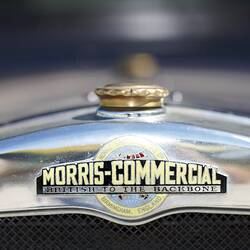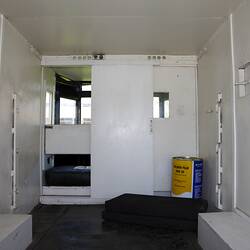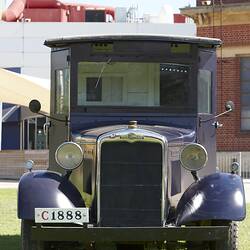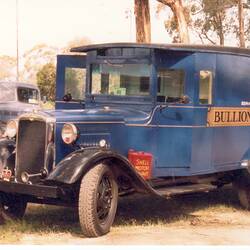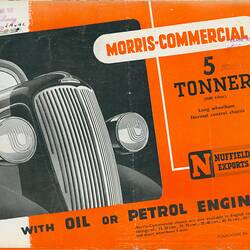Summary
Alternative Name(s): Morris Bullion Van
Armour-plated Money Van, with a local custom-built body on a standard Morris Commercial CS Series 11/30 truck chassis with 6-cylinder 3485 c.c. 55 BHP petrol engine, built in Britain, 1936. Known as "Bertha" this vehicle was used by the Note Printing section of the Reserve Bank of Australia, from about 1936 till March 1966 for making deliveries to banks and other customers. It was based at Victoria Parade Note Printing Building in Fitzroy, Melbourne and was originally one of four similar vans ordered around the same time by the Commonwealth Bank Note Printing Branch (a predecessor of the Reserve Bank Note Printing Section),
This van was donated to the South Australia Museum in October 1967, being driven from Melbourne to Adelaide on its delivery to the Museum by Charles Pobjoy, its previous regular driver with the Reserve Bank. The vehicle was housed at the Birdwood Motor Museum and was subsequently transferred to their collection. It was restored to running order by the South Australian Museum in about 1986 and later participated in the "Bay to Birdwood" Rallies in 1986, 1988 & 1990. It was donated to Museum Victoria in 2005.
Physical Description
Enclosed 1½-ton (30 cwt) capacity armoured bullion and note van with heavy-gauge steel plated body and 1-inch thick laminated armoured glass windscreen and side door windows. Painted dark blue with black mudguards and running boards and the words "SOUTH AUSTRALIAN MUSEUM BULLION CARRIER" painted on either side. Painted white inside. The van originally was of a similar colour but carried no markings apart from an insignia on the rear doors that allowed access to Commonwealth airfields in order to allow money to be loaded directly onto planes for transport interstate. Fitted with standard Morris 6-cylinder side-valve petrol engine, bore 82 mm x stroke 110 mm, capacity 3485 c.c., 25.01 R.A.C., 55 BHP; gravity-fed up draught carburettor, coil ignition, and manual ignition advance/retard lever on steering column; four-speed gearbox (double-helical gears on third); Lockheed hydraulic brakes with special cast-iron drums; semi-elliptical leaf spring front suspension and rear bronze bushes; worm sector type steering gear with 42-feet turning circle; pressed steel disc wheels with detachable split flanges and 6.50 x 20 pneumatic tyres. Dimensions: 17-ft 6-in long x 6-ft 6-in wide x 7-ft 8-in high, with 11-ft 2-in wheelbase. Tare Weight: 60 cwt (approx 3 tonnes).
Significance
This vehicle, known affectionately as "Bertha", was one of four armoured bullion vans ordered by the Commonwealth Bank in 1936 and assigned to the Note Printing Branch in Fitzroy, Victoria for armed escort duties. Its story relates to the history of Melbourne's role as the administrative centre of many emerging Commonwealth Government authorities and responsibilities during the early 20th century and to the development of Victoria's motor body industry and the emergence of motorised commercial motorised road transport in Victoria during the two decades between the First and Second World Wars.
For most of the last century, Melbourne has been the home of bank note printing within Australia. The printing and issuing of Australian bank notes did not commence until the second decade after Federation with the passing of the Australian Notes Act of 1910, transferring the government responsibilities for issuing bank notes to the Commonwealth. Prior to this notes, were general issued independently by the main commercial banks and in one case by a State Government. The 1910 Bank Notes Act withdrew the status of State issued bank notes as legal tender while the associated Bank Notes Tax Act, of 1910, also introduced a tax of 10% p.a. on notes issued by private banks, leading to a repaid demise in what was formerly the main source of legal tender. The new authority to issue bank notes was initially vested with the Commonwealth Treasury, which began by simply issued overprinting notes withdrawn from private and State Bank distribution. In 1912, Thomas Samuel Harrison was appointed as Australia's first official note printer and under his guidance a production facility was established at Kings Warehouse near the docks in West Melbourne, with the first Australian notes (of 10 shillings denomination) being produced on 1 May 1913. Subsequently in 1920, the Note Printing Branch was transferred to the responsibility of the new Commonwealth Bank and a purpose built 6-storey note printing works was constructed on Victoria Parade in Fitzroy. From here all bank notes used throughout Australia were printed and distributed, as well as many other forms of legal tender such as bank deposit certificates, promissory notes, government bonds, cheques and postage stamps.
In 1936 the Commonwealth Bank ordered four armoured "motor bullion wagons" for the Note Printing Branch, which in keeping with the practise for most Australian commercial vehicles during the inter-war period, were made with locally constructed custom-built bodies fitted to standard imported truck chasses. The 1½-ton CS series 11/30 model truck chasses with 6-cylinder petrol engines were made by Morris Commercial Cars Ltd, Adderley Park, Birmingham, England. Morris trucks at this time were one of the most popular commercial vehicles in use in Victoria, being used in a wide variety of industries. The bullion van on offer was issued to the Note Printing Branch in Fitzroy for use in delivering batches of new bank notes to the main trading banks and other major business premises throughout Melbourne and for collecting soiled and worn bank notes for destruction. It also made deliveries of notes to the central railway station and Melbourne airfields for dispatch interstate. After a long career it was finally withdrawn in March 1966, due to age and poor mechanical condition, and was donated to the South Australian Museum. The Fitzroy Note Printing Works continued to operate until 1981, when a new state-of-the-art note printing works opened at Craigieburn on Melbourne's outskirts. The former note printing building on Victoria Parade is now part of the Australian Catholic University.
More Information
-
Collecting Areas
-
Acquisition Information
Transfer from National Motor Museum of Australia, South Australian Museum, Reserve Bank (Note Issue), Jun 2005
-
Manufacturer
Morris Commercial Cars Ltd, Adderley Park, Birmingham, England, Great Britain, circa 1936
-
Past Owner or User
Reserve Bank (Note Issue), 155 Victoria Parade, Fitzroy, Greater Melbourne, Victoria, Australia, 1945-1966
-
User
Commonwealth Bank of Australia - Note Printing Branch, Melbourne, Greater Melbourne, Victoria, Australia, 1936-1945
-
Inscriptions
Radiator badge reads: 'MORRIS COMMERCIAL CARS LTD. / MORRIS-COMMERCIAL / BRITISH TO THE BACKBONE / BIRMINGHAM, ENGLAND' over an image of The World Globe.
-
Model Name or Number
-
Brand Names
-
Classification
-
Category
-
Discipline
-
Type of item
-
Overall Dimensions
5350 mm (Length), 1980 mm (Width), 2340 mm (Height), 3000 kg (Weight)
Overall Weight is an estimate only.
-
References
"Note Printing in Australia", published by Nucolorvue Productions Pty Ltd, Mulgrave, for Reserve Bank of Australia, 1988.
-
Keywords


